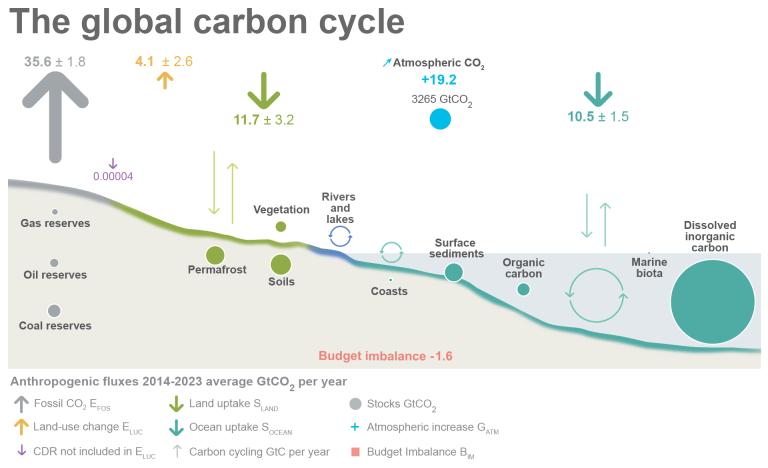Record carbon emissions highlight urgency of Global Greenhouse Gas Watch
Global carbon emissions from fossil fuels reached a record high in 2024 and there is still “no sign” that the world has reached a peak, according to new research by the Global Carbon Project – one of the contributors to WMO’s United in Science reports.

The Global Carbon Budget was released to coincide with COP29 in Baku, Azerbaijan, and adds weight to the urgency of calls for drastic and sweeping reductions in greenhouse gases, and an integrated global system to monitor them.
G20 leaders meeting in Brazil - which hosts COP30 next year - highlighted the urgency of global mobilization against climate change, reaffirming commitments to the Paris Agreement and carbon neutrality goals.
According to WMO’s State of the Climate Update, 2024 is set to be the hottest year on record, temporarily hitting the 1.5°C above the pre-industrial era. Greenhouse gas concentrations in 2023 – the last year for which data is available – also hit record levels, according to WMO’s Global Greenhouse Gas Bulletin.
Both WMO reports were presented at Earth Information Day to inform the UN Framework Convention on Climate Change Subsidiary Body for Scientific and Technological Advice (SBSTA).
In the Chair’s concluding document, SBSTA “expressed utmost concern about the state of the global climate system, with record high atmospheric greenhouse gas concentrations being observed in 2023, with 2024 being on track to be the hottest year on record, which is primarily a result of the long-term warming caused by emissions from pre-industrial times until now.”
The SBSTA noted the progress made by WMO’s Global Greenhouse Gas Watch initiative, aimed at establishing sustained, routine global monitoring of greenhouse gas concentrations and fluxes. It recognized that this initiative is intended to improve the quantification of both natural and anthropogenic greenhouse gas sources and sinks, and to complement emission inventories.
“Through the Global Greenhouse Gas Watch, we will provide more information to monitor the effectiveness of mitigation actions under the Paris Agreement. The need is more urgent than ever before,” said Celeste Saulo.
“We are heading in the wrong direction,” she said.
The long lifetime of carbon dioxide (CO2) in the atmosphere locks in temperature increase for generations to come. Until we reach net zero CO2 emissions globally, world temperatures will continue to rise and cause increasingly severe impacts – as witnessed in 2024 and recent years.
Total carbon dioxide (CO2) emissions are projected to be 41.6 billion tonnes in 2024, up from 40.6 billion tonnes last year. This includes fossil CO2 emissions of 37.4 billion, and the rest from land-use change (deforestation), according to the Global Carbon Budget.
This year, both fossil and land-use change CO2 emissions are set to rise, with drought conditions exacerbating emissions from deforestation and forest degradation fires during the El Niño climate event of 2023-2024, it said. We have seen the early signs of this impacting concentrations, as reported in the WMO Greenhouse Gas Bulletin.
“With over 40 billion tonnes released each year at present, the level of CO2 in the atmosphere continues to rise – driving increasingly dangerous global warming,” said the report. The Global Carbon Project Executive Director, Pep Canadell, recently joined the Global Greenhouse Gas Watch Advisory Panel to guide the implementation of one of WMO’s flagship initiatives.

Global Greenhouse Gas Watch
The Global G3W builds on WMO’s experience in coordinating international collaboration in weather prediction and climate analysis and on long-standing activities in greenhouse gas monitoring and research under the authority of the Global Atmosphere Watch established in 1989 and its Integrated Global Greenhouse Gas Information System.
Many of the existing international and national activities dealing with greenhouse gases are supported mainly by the research community and rely on the availability of research funds. G3W provides a platform for timely international exchange of surface and space-based greenhouse gas observations and modelling products.
“To fill critical gaps and to ensure long-term sustainability, our priority is to foster a coordinated Global Observation Network of surface and space-based sensors to measure the Greenhouse Gases accurately,” said Gianpaolo Balsamo, Director of Global Greenhouse Gas Watch.
“The Earth system responds to the laws of physics. Global temperatures must be stabilized for the sake of planetary and human health and well-being. It is not feasible to negotiate with the laws of physics, we have to work with it,” he said.










